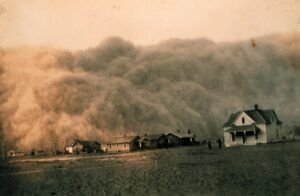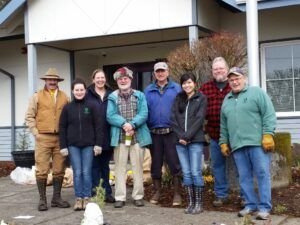Together, celebrate our conservation community this Labor Day
The theme for this post revolves around the concept of together. How we came to be together. Why we labor on conservation goals together. The sense of togetherness in our conservation community. Without the concept of together, we could not succeed. Together, we can.
What is Labor Day?
“Labor Day is observed on the first Monday in September to pay tribute to the contributions and achievements of everyday working families.”[mfn]Labor Day has Been our Holiday for More Than 100 years[/mfn] This year, Labor Day is celebrated on Monday, September 6, 2021.
An authoritative explanation of Labor Day is provided by the U.S. Department of Labor:
Observed the first Monday in September, Labor Day is an annual celebration of the social and economic achievements of American workers. The holiday is rooted in the late nineteenth century, when labor activists pushed for a federal holiday to recognize the many contributions workers have made to America’s strength, prosperity, and well-being.[mfn]History of Labor Day by the US Department of Labor[/mfn]
The first Labor Day holiday was celebrated on Tuesday, September 5, 1882, in New York City. On June 28, 1894, President Grover Cleveland signed a law making the first Monday in September of each year a national holiday.
From the Dust Bowl emerged conservation districts
The connection between Labor Day and conservation districts is a conjunction between labor in the general sense, the Great Depression, and the Dust Bowl.
“You couldn’t see. You couldn’t breathe. You couldn’t go outside for days,” remembers Eugene Littlefield. “It was awful.”[mfn]Settling the Dust, NRCS[/mfn] “It was a terrible time, Schwartz says. Many families had very little to eat. Many lived on cornbread and beans, and it almost always had a gritty taste.”[mfn]Ralph Schwartz Recalls Work On Soil Survey In Dust Bowl, NRCS[/mfn]

Most of us in the conservation district system know that our roots go back to the Dust Bowl years of the early 1930s. In 1931, “Severe drought hits the Midwestern and Southern Plains. As the crops die, the ‘black blizzards’ begin. Dust from the over-plowed and over-grazed land begins to blow.”[mfn]Timeline: The Dust Bowl, PBS[/mfn]
In 1933, the Civilian Conservation Corps was created. In 1935, Congress declared soil erosion “a national menace” when establishing the Soil Conservation Service, later to become the Natural Resources Conservation Service. In 1936, President Franklin Delano Roosevelt recommended the Standard State Soil Conservation Districts Act[mfn]Standard Soil Conservation Districts Law, PDF[/mfn] be signed into law by all state governors.
The first conservation district formed was the Brown Creek Soil and Water Conservation District established in North Carolina on August 4, 1937.[mfn]NACD HISTORY[/mfn] In Washington State, the Soil and Water Conservation Act of 1939 (codified as RCW 89.08) created a way for local communities to form conservation districts.[mfn]WA Conservation Districts: An Introduction[/mfn] Conservation districts brought people together to address their most important natural resource needs.
Washington State conservation districts chose to form a coalition of districts working together when they formed the Washington Association of Conservation Districts in 1942.
The Dust Bowl, the Great Depression, and unions
The severe impacts of the Dust Bowl formed the foundation for creating local conservation districts. This occurred during a time of severe economic hardship, resulting in the widespread loss of jobs. One response to these conditions was strengthing the federal protections for employees to come together as unions.
“The Great Depression was the worst economic downturn in the history of the industrialized world, lasting from the stock market crash of 1929 to 1939.”[mfn]Great Depression History[/mfn]More than 15 million people lost their jobs.[mfn]25 vintage photos show how desperate and desolate America looked during the Great Depression, the last time the unemployment rate was as high as it is today[/mfn]
By the end of the First World War, a primarily agrarian American society had become a primarily urban, industrialized one. Thus, on the eve of the Great Depression of the 1930’s, a larger proportion of the American people were dependent on cash wages for their support than ever before. By 1932, however, unemployment reached 34 percent of the nonagricultural workforce. Between 1929 and 1932, national income dropped by 43 percent, per capita income by 19 percent. By the mid-1930’s, the lifetime savings of millions of people had been wiped out.[mfn]Fifty Years of Social Security[/mfn]
Words alone cannot adequately describe the misery and suffering of the time. Making matters worse, the Dust Bowl stormed into existence in the early 1930s, accentuating economic impacts on farms and those who depended on them. “The environment also seemed hostile to the farmers during the 1930s.”[mfn]Great Depression and the Dust Bowl[/mfn]
Alas, the Dust Bowl coincided with the Great Depression. Jobs were scarce, and those who still had jobs were loath to lose them to migrants. And so they unionized.[mfn]The Surprising Connection Between 1930s Weather And Today’s Labor Unions, Forbes[/mfn]
In the early 1930s, unionization efforts quickly progressed, with the federal government and labor forces working together to help create conditions that were better for American workers.
The tremendous gains labor unions experienced in the 1930s resulted, in part, from the pro-union stance of the Roosevelt administration and from legislation enacted by Congress during the early New Deal. The National Industrial Recovery Act (1933) provided for collective bargaining. The 1935 National Labor Relations Act (also known as the Wagner Act) required businesses to bargain in good faith with any union supported by the majority of their employees.[mfn]Labor Unions During the Great Depression and New Deal[/mfn]
Conservation districts and unions
Even though conservation districts sprang from the Dust Bowl – just as collective bargaining did – conservation districts themselves did not unionize until just a few years ago. “The union membership rate of public-sector workers (34.8 percent) continued to be more than five times higher than the rate of private-sector workers (6.3 percent).”[mfn]Union Members – 2020, Bureau of Labor and Statistics[/mfn] It seems safe to conclude that union membership in conservation districts was going to happen somewhere, sometime. That moment arrived for us just a few years ago: Washington State leads the nation with the first two conservation districts in which employees voted to unionize.
As you celebrate Labor Day, also celebrate conservation districts
I could argue that conservation districts helped return American agriculture to a stable, productive segment of our economy after the worst economic disaster ever recorded. Working together with the Soil Conservation Service (now the Natural Resources Conservation Service) and land grant universities[mfn]Land-grant university, Wikipedia[/mfn], local conservation districts helped agricultural producers implement conservation practices designed to save the future of American farms. In conjunction with federal and state programs, conservation districts provided relief, recovery, and reform to farmers throughout the nation.

Labor Day is about all workers and we are all workers. Paid or unpaid, we all contribute to advancing our voluntary, non-regulatory conservation philosophy. We contribute to progress and prosperity. This is especially the case in our conservation district community where we consciously set aside individual beliefs, working together to help conserve natural resources. As our Dust Bowl history shows, the quantity and quality of natural resources are crucial to our economy and our people.
The preamble to Conservation Districts Law[mfn]RCW 89.08.010 Preamble to Conservation Districts Law[/mfn] (Revised Code of Washington chapter 89.08) is instructive on how the State of Washington views the important role of conservation districts in conserving natural resources. If you haven’t read it recently, it’s worth a few minutes to revisit the sweeping charge placed on conservation districts. It helps put into perspective why, despite our many differences, our people come together to solve natural resource opportunities.
The context provided in the preamble to RCW 89.08 is daunting. It is exceptionally wide in scope because natural resource issues cut across all of our political, demographic, and socio-economic boundaries: they affect everyone. The work we labor to do in conserving natural resources is both necessary and honorable. Every day I celebrate the people who, together, make our conservation delivery system work so well. On Labor Day, I hope you’ll join me in remembering the hundreds of people who devote their energy and hearts every day to the vital work of conserving our precious natural resources. We do that together.
